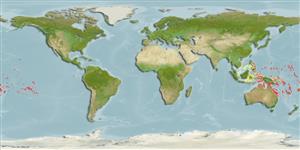>
Ovalentaria/misc (Various families in series Ovalentaria) >
Pseudochromidae (Dottybacks) > Pseudoplesiopinae
Etymology: Pseudoplesiops: Greek, pseudes = false + Greek, plesios = near (Ref. 45335).
Eponymy: Commander Roger Randall Dougan Revelle (1909–1991) of the US Naval Reserve was in charge of oceanographic studies during Operation Crossroads (the post-war atomic tests) and the Bikini Scientific Re-survey. [...] (Ref. 128868), visit book page.
More on author: Schultz.
Environment: milieu / climate zone / depth range / distribution range
Ecologia
marino associati a barriera corallina; distribuzione batimetrica 3 - 20 m (Ref. 30874). Tropical; 16°N - 26°S
Pacific Ocean: Mariana Islands, Marshall Islands, and eastern Caroline Islands to the Pitcairn Group.
Size / Peso / Age
Maturity: Lm ? range ? - ? cm
Max length : 3.5 cm TL maschio/sesso non determinato; (Ref. 30874)
Spine dorsali (totale) : 1; Raggi dorsali molli (totale) : 27 - 28; Spine anali: 1 - 3; Raggi anali molli: 17 - 18. SL to 32 mm.
Occurs in inshore reef areas (Ref. 7300).
Life cycle and mating behavior
Maturità | Riproduzione | Deposizione | Uova | Fecundity | Larve
Paxton, J.R., D.F. Hoese, G.R. Allen and J.E. Hanley, 1989. Pisces. Petromyzontidae to Carangidae. Zoological Catalogue of Australia, Vol. 7. Australian Government Publishing Service, Canberra, 665 p. (Ref. 7300)
IUCN Red List Status (Ref. 130435: Version 2024-2)
Threat to humans
Harmless
Human uses
Strumenti
Special reports
Download XML
Fonti Internet
Estimates based on models
Preferred temperature (Ref.
123201): 25 - 29.4, mean 28.4 °C (based on 1249 cells).
Phylogenetic diversity index (Ref.
82804): PD
50 = 0.5020 [Uniqueness, from 0.5 = low to 2.0 = high].
Bayesian length-weight: a=0.01122 (0.00514 - 0.02450), b=3.04 (2.87 - 3.21), in cm total length, based on all LWR estimates for this body shape (Ref.
93245).
Trophic level (Ref.
69278): 3.2 ±0.5 se; based on size and trophs of closest relatives
Fishing Vulnerability (Ref.
59153): Low vulnerability (10 of 100).
Nutrients (Ref.
124155): Calcium = 277 [146, 657] mg/100g; Iron = 1.41 [0.72, 2.52] mg/100g; Protein = 18.8 [17.6, 20.0] %; Omega3 = 0.186 [0.090, 0.399] g/100g; Selenium = 25.5 [10.0, 56.9] μg/100g; VitaminA = 141 [40, 501] μg/100g; Zinc = 3.12 [1.89, 4.84] mg/100g (wet weight);
